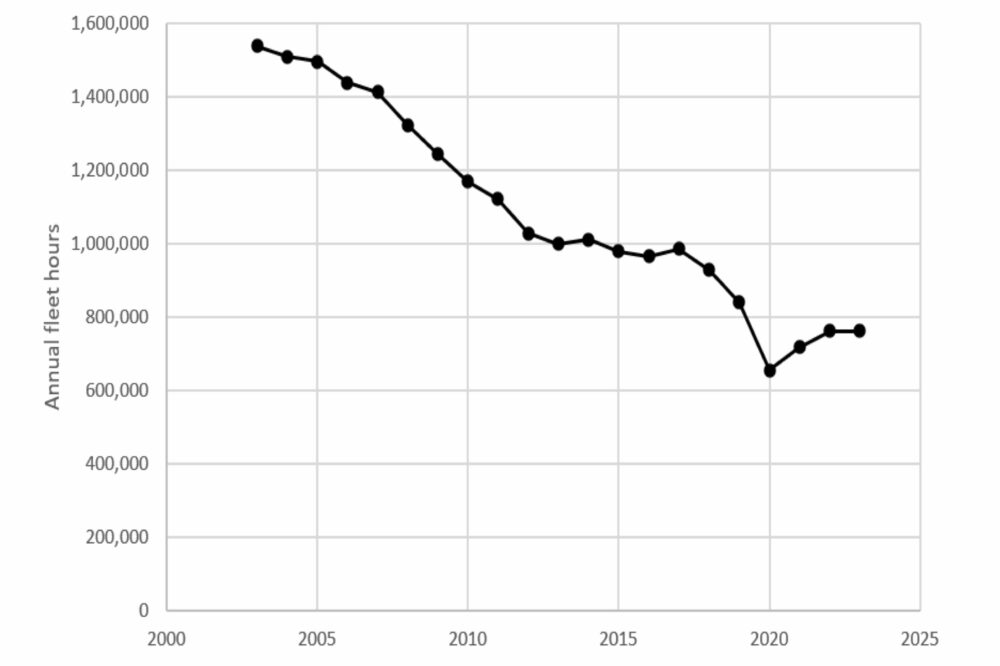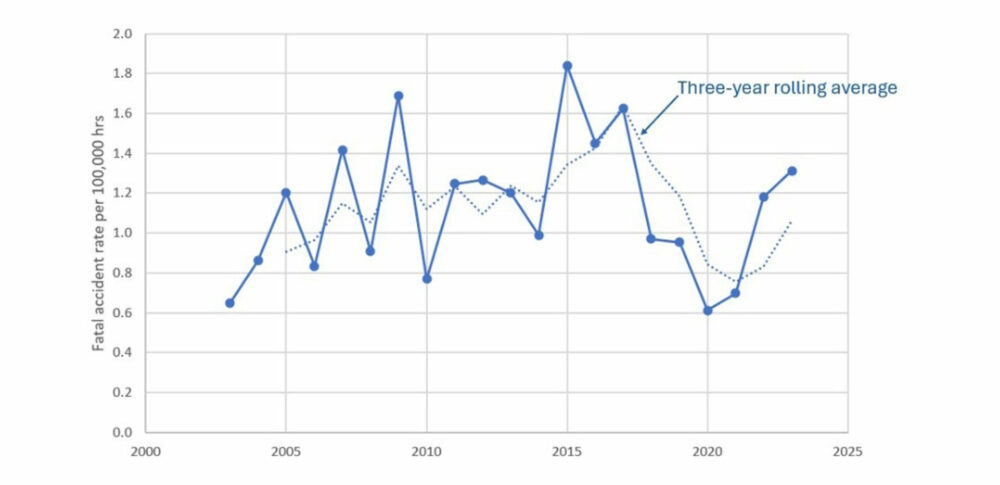At the end of March, the Air Accidents Investigation Branch published its Annual Safety Review. Chief Inspector Crispin Orr said, “In 2023 there were 10 fatal air accidents in the UK resulting in 11 deaths. All involved General Aviation. “While this number of fatal accidents was not unusual, they all occurred in the summer months and the fatal glider mid-air collision was the first for nine years. Loss of control in flight continues to be the prevalent cause of fatal accidents.”
GA flying hours trend down…
1The annual hours flown by the UK GA fleet fell by approximately half during the period, with a steady decline between 2003 to 2012. This initial decline was followed by a relatively constant period of annual hours flown between 2012 and 2017, with a second steep decline occurring, which started before, but also encompassed, the pandemic. Hours have still not recovered to pre-pandemic levels as of 2022-23.

…but the accident rate is getting worse…
2The three-year rolling average showed that the fatal accident rate was approximately constant between 2007-2015, before rising to a small peak of about 1.6 per 100,000 hours in 2017. The fatal accident rate then declined, falling to a low in 2021, but it’s now rising in what seems to be a longer-term trend.
To put it another way, the amount of GA flying per year has halved over the period but the number of fatal accidents has not reduced by the same amount, in fact in 2023 it was the same number as 2003 (10 fatal accidents). The reasons behind this rise in the accident rate are not clear but clearly needs to be understood.

… and Mid-Air Collisions (MACs) are a lot higher than in the US
3For the period 2003-2023, 39 collisions involving 78 aircraft occurred in the UK which equated to a collision rate of 0.341 per 100,000 hours flown. The US collision rate was 0.092 per 100,000 hours flown or approximately one quarter of the rate in the UK. The report laconically states: “Further study would be required to analyse the contributory factors to this large difference in MAC rates between the UK and the USA, and to also compare the MAC rates in other European countries.”
The introduction of FLARM in the UK glider fleet appears to have significantly reduced the number of collisions between gliders and the 2023 Melton Mowbray MAC event was the first glider-glider collision to have occurred for nine years. This would appear to reinforce the benefits of using a single type of collision avoidance system. It is not yet known whether the introduction of a variety of Electronic Conspicuity systems has helped to reduce the rate of collisions for powered aircraft.
Biggest safety issue continues to be Loss of Control in Flight
4A variety of statistics in the report highlight the fact that LOC-I continues to be the largest single cause of accidents and fatalities. The report rightly highlights that, “The key safety messages to avoid loss of control have been reinforced in revised promotional materials published by the Civil Aviation Authority”, but there appears to be no desire by the regulators to address the fundamental training issues underlying these statistics.
Perhaps now is the time to revisit the flight training syllabus to ensure this critical LOC-I arena receives the focus it deserves – and almost certainly to ensure that all Flying Instructors have received appropriate Upset Prevention and Recovery Training.
Improved co-operation between AAIB and CAA
5The CAA appears generally to be working well with the AAIB around GA issues, with decent coordination on safety issues, many of which stem from AAIB safety recommendations. The actions following the G-BXBU Cap 10 accident is a good example, with several partially adequate responses but good engagement to try to close the gaps.
The way forward?
6The number of fatal accidents involving GA aircraft has not reduced in proportion to the hours flown, and the fatal accident rate has increased above a long-term trend in the last five years. The mid-air collision rate in the UK is considerably higher, by a factor of four, than in the USA. The AAIB has stated that it plans to work with stakeholders to identify underlying factors for both the GA fatal accident rate and the MAC rate, to support further safety promotion on these topics.
Perhaps the question ‘is this enough?’ should be asked, especially when LOC-I stubbornly continues to be the largest single safety issue and yet no changes to GA pilot training are even being considered.